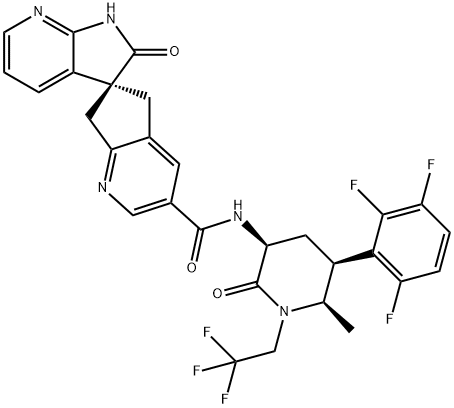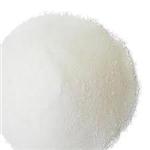Structure
Atogepant (MK-8031/AGN-241689) is a polycyclic molecule containing four chiral centers and three aromatic and aliphatic rings. An intriguing feature is the 2-azaspiro [4.4]nonan-1-one (spiroazaindane) motif in an S configuration, also present in earlier preclinical leads from Merck. The azospiro bispyridine unit is linked via an amide bond to a piperidine-2-one ring; the amide linkage is reversed to that seen in earlier leads to avoid the potential release of a toxic aniline. The piperidine-2-one ring is heavily functionalized with 6-(R)-methyl, 5-(R)-2,3,6-trifluorophenyl substituents. The 2,3,6 pattern of fluoro substituents provided a ~fourfold increase in atogepant affinity compared with ubrogepant, which contains an unsubstituted phenyl ring. The fluorine substitution pattern in atogepant may be responsible for alleviating the hepatotoxicity associated with some other gepants, such as telcagepant. Notably, the piperidinone is masked with a 2,2,2,-trifluoroethyl group, a substitution that provided improved telcagepant's potency, bioavailability, and half-life. Atogepant’s molecular weight (603 g/mol), the presence of five H-bond acceptors and two H-bond donors, and its large polar surface area (109.29 Å2) may limit penetration via passive diffusion through the blood-brain barrier.
Uses
Atogepant (MK-8031) is an orally active and selective calcitonin gene–related peptide receptor (CGRP) antagonist. Atogepant can be used for researching migraine.
Definition
ChEBI: Atogepant is a secondary carboxamide resulting from the formal condensation of the carboxy group of (3'S)-2'-oxo-1',2',5,7-tetrahydrospiro[cyclopenta[b]pyridine-6,3'-pyrrolo[2,3-b]pyridine]-3-carboxylic acid with the amino group of (3S,5S,6R)-3-amino-6-methyl-1-(2,2,2-trifluoroethyl)-5-(2,3,6-trifluorophenyl)piperidin-2-one. It is a selective oral, small-molecule antagonist of calcitonin gene-related peptide (CGRP) receptor that has been approved for the treatment of migraine. It has a role as a calcitonin gene-related peptide receptor antagonist. It is a secondary carboxamide, an azaspiro compound, an organic heterotetracyclic compound, a trifluorobenzene and a member of piperidones.
Mechanism of action
Atogepant (MK-8031) is an antagonist of the calcitonin gene-related peptide receptor. It competes with CGRP for occupancy at these receptors, preventing the actions of CGRP and its ability to induce and perpetuate migraine headache pain.
Side effects
The side effect profile of atogepant is similar to other gepants, most frequently including constipation, nausea, upper respiratory and urinary tract infection, and appearing similarly in long-term follow-up studies and clinical trials. Currently, there is no data on the safety of atogepant treatment during pregnancy or lactation. However, it can be assumed, based on animal data, that it is able to pass into breast milk.


